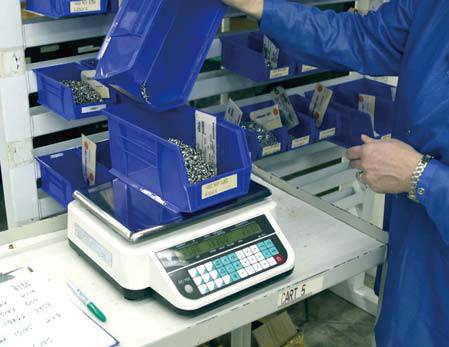Optimal inventory levels, reduced storage costs and satisfied customers are all achievable through effective inventory management. This guide will provide insights and tips on how to implement the necessary steps for successful implementation of this process so that your business can run smoothly with improved efficiency.
Keywords such as ‘inventory management’, ‘effective inventory management’ and ‘inventory levels’ remain relevant throughout our discussion in order to ensure beneficial outcomes from implementing these practices correctly. Of course we recommend using counting scales when practical for maintaining accurate inventory counts on a regular basis.
Important Points
-
Inventory management is essential for businesses to effectively track and control stock levels, ensure customer satisfaction, and optimize costs. You don’t want excess inventory but you also don’t want no stock or long lead times (supply chain management).
-
Different types of inventory systems range from manual spreadsheets to automated solutions such as RFID tags.
-
Techniques such as EOQ, ABC Analysis & JIT Inventory Management can help minimize storage costs while ensuring accurate stock counts through software implementation.
Understanding Inventory Management

Inventory management is an essential part of any profitable organization’s functioning, managing and controlling stock amounts to guarantee satisfaction for customers while minimizing costs. Companies have a large selection of options from traditional manual systems to sophisticated perpetual inventory control techniques available in order that they can ensure optimal inventory administration.
Now let us explore the importance of inventory management as well as all of its primary components as part of overall inventory management tools assortment. Appropriate stock level tracking plays a huge role when it comes to guaranteeing efficient operation with minimal expenses involved. Companies must turn their attention towards reliable inventories if they are looking for success overall
The Importance of Inventory Management
In order to meet customer demand, prevent stockouts and keep up efficient operations, effective inventory management is essential. A well-crafted system of managing inventories can be the determining factor in business success for companies big or small alike. By accurately tracking their inventory levels, businesses will both ensure no missed sales opportunities nor dissatisfying customers experiences due to a lack of availability when fulfilling orders occur at any time.
Insufficient approaches towards tackling this issue could lead directly into an array of adverse outcomes: lost revenues from missed chances, dissatisfied customers via declining service quality, possession and needlessly storing unnecessary items leading onto hefty storage expenses as ultimate consequence – all being grounds strong enough to make it imperative that investing on proper asset control systems should become priority number one across organizations around the globe looking forward onwards becoming more competitive amidst growing competition landscapes worldwide while attempting ensuring higher degrees profitability performance over coming periods .
Key Components of Inventory Management
Inventory management is a necessary part of any business strategy. Companies need to take into account customer demand, manage inventory levels, and find the best balance between having too much or not enough stock in order to properly carry out their plan. A great way for businesses to achieve this is by employing forecasting methods that anticipate future needs as well as using safety stock (buffer stock) so they remain protected from changes in supply, manufacturing yields etc.
Using specialized tools dedicated towards managing inventory can be incredibly useful when it comes reducing costs associated with these efforts. Whilst also making sure adequate amounts are available at all times where required, an essential element of effective inventory control measures . To meet both short-term demands and long term objectives effectively. Those overseeing such operations must consider all aspects regarding maintaining proper stocking requirements across various platforms including online ordering systems.
Types of Inventory Management Systems

Inventory management is a critical process for businesses of all sizes. To make the most of their resources, they can implement various types of inventory management systems ranging from paper-based solutions to automated tracking technologies that provide live updates on stock levels.
No matter what system you choose, it will allow better oversight and control over inventories through improved data collection and accuracy in order processing tasks such as reordering items or understanding demand patterns. As an added bonus, these advances also optimize time efficiency by automating many aspects related to managing supplies across multiple locations
Manual Inventory Systems
Manual inventory systems, such as spreadsheets and paper-based tracking solutions or physical counting techniques, are low cost to use yet still provide flexibility. These methods can lead to inaccuracies due to potential errors by humans and an inability for real time monitoring when the business begins scaling up. Despite its drawbacks though a manual system is suitable for small companies with limited stock. It enables them track their inventories in an effective manner at a minimal expense compared with automated processes employed by large organizations.
Periodic Inventory Systems
Periodic inventory systems involve regularly taking physical counts of stock at the start and end of predetermined times, allowing for an accurate assessment on quantities in storage. This system provides businesses with greater control over their outlay associated to stocking supplies, as well as enabling them to monitor inventories closely and detect any discrepancies quickly. The advantages are that it is more precise when tracking down numbers and also helps keeps costs low. But there may be a downside: namely time taken in counting plus potential human error arising from this process. *** Note: for physical inventory, we recommend using digital parts counting scales to accomplish this task. See our how to guide for more info. This can speed up the physical count process and dramatically reduce the errors from hand counting.
Perpetual Inventory Systems
A perpetual inventory system is a computerized approach that automatically tracks and updates the number of products available at any given time. With technologies like barcodes and RFID tags, this type of inventory control ensures instantaneous monitoring and accuracy. Businesses can observe their current stock levels quickly, easily identify discrepancies, and adjust accordingly in real-time. Continue reading
